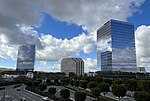Irvine Bean and Growers Association Building

Irvine Bean and Growers Association Building, sometimes referred to as the Sack Storage Warehouse or the Bean Warehouse Building, at 14952 Sand Canyon Ave. in Irvine, California, was built in 1895. It was listed on the National Register of Historic Places in 1986. It was used as a storage facility for trains on the tracks directly to the west of the building. It could up to 200,000 sacks of 100 pounds each holding lima, garbanzo, black-eyed beans, barley, or oats. The building measures 450 feet long and 40 feet wide. Inside the warehouse was two fumigation rooms which could hold up to 500 sacks which took a full day to fumigate. Today, it is split into a multi-use development. With the northern half being used as a hotel and the southern half for office space.
Excerpt from the Wikipedia article Irvine Bean and Growers Association Building (License: CC BY-SA 3.0, Authors, Images).Irvine Bean and Growers Association Building
Santa Ana Freeway, Irvine Cypress Village
Geographical coordinates (GPS) Address Nearby Places Show on map
Geographical coordinates (GPS)
| Latitude | Longitude |
|---|---|
| N 33.674722222222 ° | E -117.75694444444 ° |
Address
Old Towne Irvine
Santa Ana Freeway
92618 Irvine, Cypress Village
California, United States
Open on Google Maps




